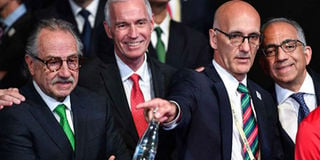North America to host 2026 World Cup

President of the Mexican Football Association Decio de Maria Serrano (left), Steve Reed (second left), president of the Canadian Soccer Association, Carlos Cordeiro (right), President of the United States Football Association, attend the 68th Fifa Congress at the Expocentre in Moscow on June 13, 2018. PHOTO | MLADEN ANTONOV |
What you need to know:
- Delegates had been faced with a clear choice — the joint North American bid boasts modern, established stadiums and well-developed transport links underpinned by Mexican football fervour.
- Morocco, on the other hand, promised a "European" World Cup in Africa, playing on the north African nation's proximity to Europe.
MOSCOW
The decision to award the 2026 World Cup to North America on Wednesday follows an explosion in football's popularity across the region which can be traced directly to the 1994 finals staged in the United States.
For decades, the United States was regarded as the final frontier for the world's most popular sport, with the beautiful game unable to encroach on territory dominated by baseball, basketball and American football.
A promising flirtation with the sport in the 1970s — when stars like Pele, Franz Beckenbauer and Johan Cruyff lit up the North American Soccer League — flamed out when the league was wound up in 1984.
"Soccer: sport of the future — and it always will be," ran the old joke beloved of American football-sceptics.
Yet the dynamic began to shift, however, when the USA was handed the 1994 World Cup.
A total of 3,587,538 spectators thronged stadia across the United States for the country, generating an average attendance of 68,991 fans per game, a record which exists to this day.
More significantly, as a condition of the USA being awarded the tournament, a professional domestic competition was re-established, Major League Soccer.
That league launched in 1996 with 10 teams. It has since expanded to 23 teams across the US and Canada, with three more due to join by 2020, eventually expanding to 28 clubs.
In 2017, MLS drew average crowds of 22,113, making it the seventh best attended top-flight competition in the world, ahead of leagues in France, the Netherlands and Argentina.
"The development of the national team and the creation of Major League Soccer wouldn't have happened without the World Cup," Los Angeles lawyer Alan Rothenberg told the Los Angeles Times in a 2014 interview.
"The whole sport got elevated from what was essentially a hand-to-mouth grassroots operation to a well-funded, well-run professional organization."
CHANGING DEMOGRAPHICS
At grassroots level, football in the United States is thriving, with more than 24.4 million Americans playing the sport at some level, second only to China, according to Fifa figures.
There is also evidence that football is changing the demographics of armchair sports fans in the US.
A Gallup survey published in January found that 7% of Americans named football as their favourite sport, a significant three-point jump from four years earlier.
While the NFL (37%), basketball (11%) and baseball (9%) remain ahead of it, soccer is rapidly creeping up on the rails.
Crucially soccer is capturing the key demographic of younger fans.
While only 1% of American sports fans older than 55 named soccer as their favourite sport, that number jumps to 11% in the 18-34 age group, tying basketball and comfortably ahead of baseball (6%).
The increases in participation and popularity are mirrored by the steady growth of football on US television networks.
The English Premier League has broadcast live games on the main NBC network for several years, while the Bundesliga, La Liga, Ligue 1 and the Champions League are also readily available on various cable networks.
Coverage of soccer in US media outlets has also expanded, with the New York Times in 2016 creating a position for a chief soccer correspondent based in London, an appointment described by the paper as a "huge move."
While the 2026 World Cup will be hosted by Canada, the United States and Mexico, the US will stage the bulk of the games.
Sixty of 80 matches in the 48-team tournament will be held in the United States, with the US hosting every game from the quarter-finals onwards.
In an interview with AFP last year, MLS commissioner Don Garber said the 2026 tournament in North America would "set an entirely new bar for World Cups."
"We have the facilities, we have the market, we have the support," he said.





